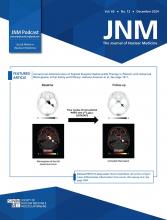REPLY: Thank you for the opportunity to address the concerns of Fodor et al. (1) and Watabe (2) regarding the PRECISE-MDT study (3).
First, we acknowledge that the prostate cancer treatment landscape has evolved significantly in recent years. A more detailed analysis of concurrent systemic treatments administered alongside metastasis-directed therapy (MDT) would have strengthened our findings. Nonetheless, following the suggestion of Fodor et al. (1), we performed an additional regression model to compare patients undergoing choline PET/CT versus those undergoing PSMA PET/CT–guided MDT, excluding those who received concurrent systemic treatment. Despite the reduced sample size, the differences in progression-free survival (PFS) and PFS2 remain evident (see Supplemental Table 1; available at http://jnm.snmjournals.org). We agree that MDT should not be considered an alternative to systemic treatment. However, in selective cases, particularly among older and comorbid patients, MDT can be an effective and well-tolerated means to control macroscopic disease, delay disease progression, and defer the adverse events associated with systemic treatments.
We also acknowledge that some metaanalyses have reported no significant differences in the diagnostic performance of choline and prostate-specific membrane antigen (PSMA) PET/CT for detecting recurrence at higher prostate-specific antigen (PSA) serum levels. However, in a prospective, randomized, cross-over phase III study, Olivier et al. (4) demonstrated that [18F]-PSMA-1007 PET/CT is superior to [18F]-fluorocholine PET/CT in localizing prostate cancer recurrence. This advantage was observed across all PSA-level subgroups and not just in patients with a PSA of no more than 1 ng/mL. Therefore, the superior performance of PSMA in guiding MDT is not entirely surprising.
The comparison between [68Ga]-PSMA-11 and [18F]-PSMA-1007 is more complex because of the limited availability of head-to-head or matched-pair comparative data. The systematic review (5) cited by Fodor et al. (1) includes only 3 studies offering direct comparisons, none using a true gold standard. Thus, there is still insufficient data to consider PSMA ligands as definitively interchangeable. To quote Carl Sagan, one of the leading science communicators of the 20th century, “absence of evidence is not evidence of absence” (6).
Regarding the higher frequency of unspecific bone uptake (UBU) associated with [18F]-PSMA-1007 (7) as a potential reason underlying the observed differences, we generally agree with the criticisms raised in both letters. Irradiating benign sites could result in “overtreatment,” though it would not necessarily shorten the time to oncologic endpoints. However, instances of UBU complicate image interpretation, particularly for less experienced PET readers (8). On the one hand, true bone metastases may have been misinterpreted as UBU, potentially leading to undertreatment and inaccurate MDT targeting. On the other hand, UBU in follow-up scans could have been mistaken for distant recurrences, interpreted as progression, and prompted premature changes in systemic treatment. As Watabe pointed out (2), the absence of a central imaging review may have introduced heterogeneity in interpretation, potentially affecting these results. However, our findings likely reflect real-world conditions, where less experienced physicians may also interpret [18F]-PSMA-1007 PET/CT scans and face these challenges.
Finally, the limitations raised by both letters stem from our study’s retrospective design. Only prospective, randomized trials can provide high-quality evidence. Nevertheless, every practice-changing prospective study was built on the foundation of retrospective evidence.
Matteo Bauckneht*, Francesco Lanfranchi, Liliana Belgioia
Department of Health Sciences, University of Genoa Genova, Italy
*E-mail: matteo.bauckneht{at}unige.it
Footnotes
Published online Oct. 17, 2024.
- © 2024 by the Society of Nuclear Medicine and Molecular Imaging.
REFERENCES
- Received for publication September 23, 2024.
- Accepted for publication September 30, 2024.







